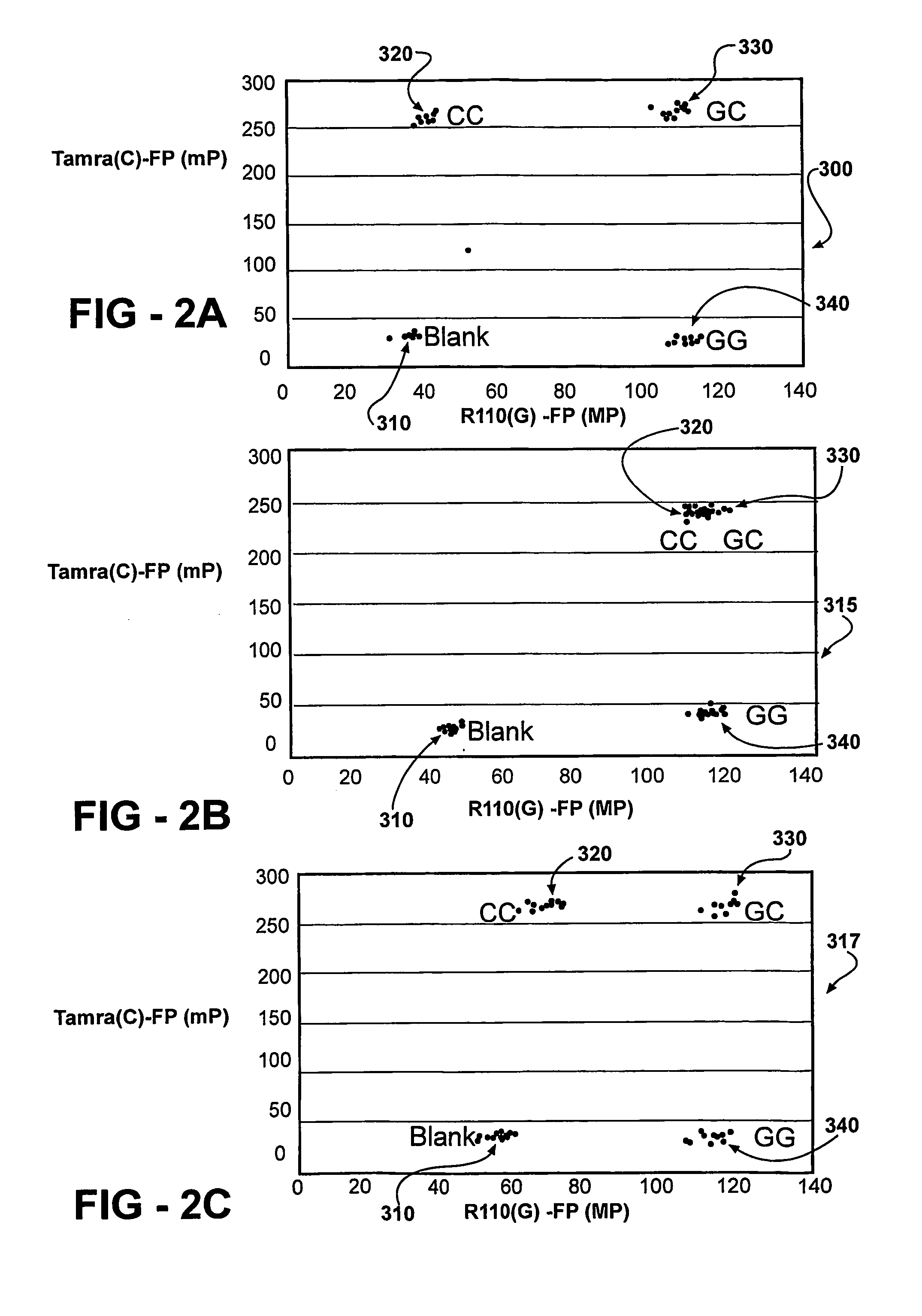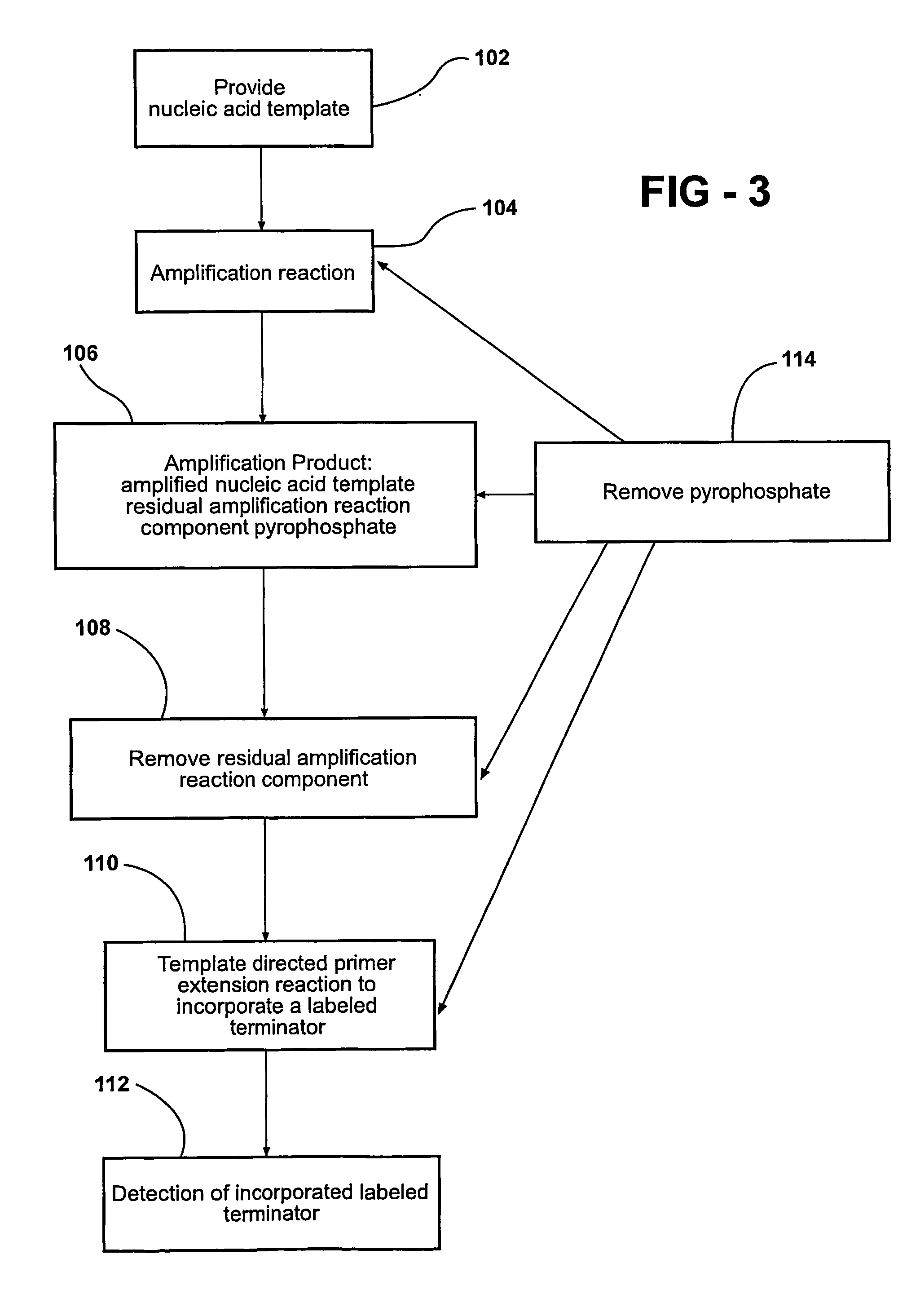Compositions and processes for genotyping single nucleotide polymorphisms
- Summary
- Abstract
- Description
- Claims
- Application Information
AI Technical Summary
Benefits of technology
Problems solved by technology
Method used
Image
Examples
example 1
[0088] Anonymous DNA samples of 96 individuals from the National Institutes of Health (NIH) Polymorphism Discovery Panel and CEPH family and publicly available markers from dbSNP database are used in this study. All primers are designed as described previously (Vieux et al. 2002) and are obtained from IDT. All reactions are run and read in 96-well or 384-well black plates from LabSource. Liquid handling instrument Evolution P3 (PerkinElmer) is used for assay assembly. PlatinumTaq DNA polymerase is from Invitrogen. AcycloPrime-FP SNP Kits are from PerkinElmer, including 10× reaction buffer, AcycloPol Enzyme for single base extension, PCR Clean-Up reagent (exonuclease I and shrimp alkaline phosphatase) and dilution buffer, and dye-labeled AcycloTerminator™ mixture, which contains equal amounts of R110 and TAMRA terminators. PPi is purchased from Sigma. Pyrophosphatase is from Roche. Texas red-labeled AcycloTerminators™ are from PerkinElmer. The assays are read in an Envison or Victor2...
example 2
[0089] Primer Extension Reaction Using Synthetic Oligodeoxynucleotides
[0090] For each primer extension reaction using synthetic oligodeoxynucleotides, two template oligodeoxynucleotides are synthesized, each with one of the two allelic bases at the target site. The heterozygous templates are made by mixing equal amounts of the two synthetic templates. The template sequences of four such reactions are summarized in Table 3.
TABLE 3Sequence of Synthetic Oligodeoxynucleotides and Extension PrimersSynthetic oligodeoxynucleotidesas extension templatesExtension primersMisincorporationTemplate 1 (G / C)GTGGTGTTCCTCTTCGAAGGGCTTGCTAATCCTTGGCCAAGGATTAGCAAGCCCTTCGAAGAGG allele for CCCCCAclusterGTGGTGTTGCTCTTCGAAGGGCTTGCTAATCCTTGGCCCATemplate 2 (G / A)AGTGGATCCCACTGTCGATGGAGATGCCTGAGAAACTCAGGCATCTCCATCGACAGTGGGG allele for AAGACCCclusterAGTGGACCCCACTGTCGATGGAGATGCCTGAGAAACTCAGGCATCTCCATCGACAGTGGGGACCCTemplate 3 (A / T)ACGAAAATTTTGCTAGTGGTTTACCCATGGTCATACTATGACCATGGGTAAACCACTAGCAAAAA allele for TTGC...
example 3
[0092] PCR / TDI Reaction with or without Pyrophosphatase
[0093] All reactions are performed according to the manufacturer's manual. Briefly, DNA (3 ng) is amplified in 5 microliter reaction mixtures containing PCR primers and PCR reagents by using the following thermal cycling protocol: The mixture is held at 95° C. for 2 min followed by 40 cycles of 10 sec at 92° C., 20 sec at 58° C., and 30 sec at 68° C. The reaction mixtures are then incubated for 10 min at 68° C. before they are held at 4° C. until further use. Pyrophosphatase (1.5 microliters) is added to a stock solution of PCR clean-up enzyme mixture (10.5 microliters of 10× buffer, 1.33 microliters Exo-SAP). The PCR clean-up mixture (2 microliters) is added to 5 microliters PCR product mixture and incubated from 1 h at 37° C. to degrade the excess PCR primer, excess dNTP, and PPi generated during PCR. The enzymes are heat-inactivated for 15 min at 80° C. prior to the TDI reaction. TDI cocktail (13 microliters) is added to the...
PUM
| Property | Measurement | Unit |
|---|---|---|
| Fluorescence | aaaaa | aaaaa |
| Affinity | aaaaa | aaaaa |
| Alkalinity | aaaaa | aaaaa |
Abstract
Description
Claims
Application Information
 Login to View More
Login to View More - R&D
- Intellectual Property
- Life Sciences
- Materials
- Tech Scout
- Unparalleled Data Quality
- Higher Quality Content
- 60% Fewer Hallucinations
Browse by: Latest US Patents, China's latest patents, Technical Efficacy Thesaurus, Application Domain, Technology Topic, Popular Technical Reports.
© 2025 PatSnap. All rights reserved.Legal|Privacy policy|Modern Slavery Act Transparency Statement|Sitemap|About US| Contact US: help@patsnap.com



